#sponge reef
Text
Death of a leedsichthys problematicus

#paleoillustration#paleo meme#paleo art#paleontologist#paleozoic#paleoblr#paleoart#paleontology#paleostream#leedsichthys#jurassic period#rhamphorhynchus#liopleurodon#ocean#lineart#sketchbook#whale#filter feeder#sponge reef
24 notes
·
View notes
Text

Yellow tube sponge (Aplysina fistularis)
Photo by Alex Mustard
#yellow tube sponge#tube sponge#sponge#aplysina#aplysina fistularis#verongiida#sea sponge#yellow#aquatic#marine#marine life#sea#ocean#coral reef#reef#marine invertebrates#marine animals#nature
183 notes
·
View notes
Text

Stony sentinels
Belize, 2018
purgatorie
#purgatorie#coral reef#coral#belize#tropical#snorkeling#reef#ocean#underwater#underwater photography#sea fan#tropical fish#fish#reef fish#sea sponge#sea#travel photo#2018#goprophotography#gopro#carribbean
41 notes
·
View notes
Photo
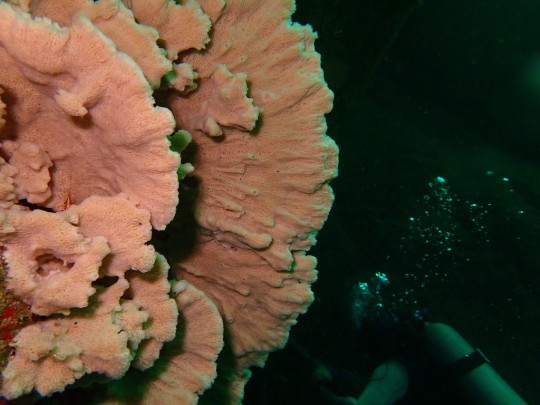
FUTURE OCEAN CONDITIONS INDUCE NECROSIS IN REEF SPONGES
Oceans are rapidly warming and acidifying in the context of climate change, threatening sensitive marine biota including coral reef sponges, oceans more acids and hot can can impact host health and associated microbiome. Now, australian scientists have found when areef sponge is exposed to a 3 °C increase in seawater temperature, as is expected in the future, the sponge loses an important microbe, which could explain why sponge tissue dies.
Marine sponges are highly diverse, filter-feeding benthic animals, which play essential roles in the ocean, such as providing shelter and home to other animals, they collect bacteria, and process carbon, nitrogen, and phosphorus. Thse microbe partners play key roles that contribute to host health and survival of the sponge, including energy provision to the host, waste removal, amino acid and secondary metabolite production and chemical defence.

- A healthy reef sponge (left) versus a necrotic one (right) in the lab conditions. Credit: Holly Bennett
The symbiosis between the reef sponge and its microbes is weak to warm oceans, and may not be stronge to the high temperatures that are predicted to become averages by the end of the century.
Photo by David Gúmera
Reference (Open Access): Botté et al.2023 Future ocean conditions induce necrosis, microbial dysbiosis and nutrient cycling imbalance in the reef sponge Stylissa flabelliformis. ISME COMMUN.
#reef sponge#Stylissa flabelliformis#climate change#science#biology#sciblr#scienceblr#bioblr#biologyblr#marine biology#marine science#ocean acidification
125 notes
·
View notes
Text

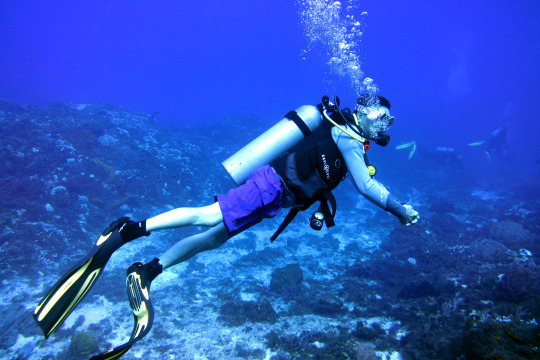
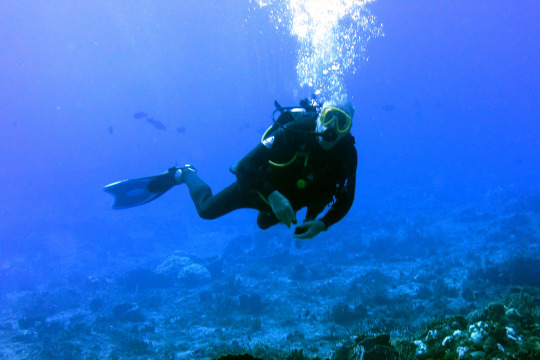







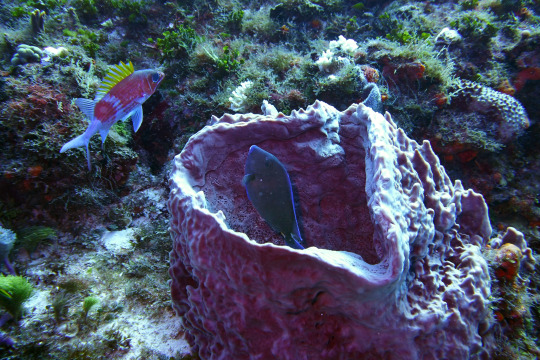

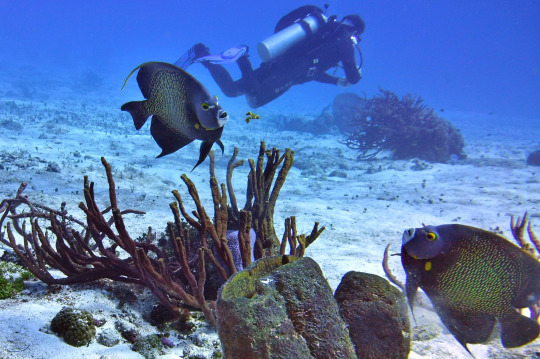

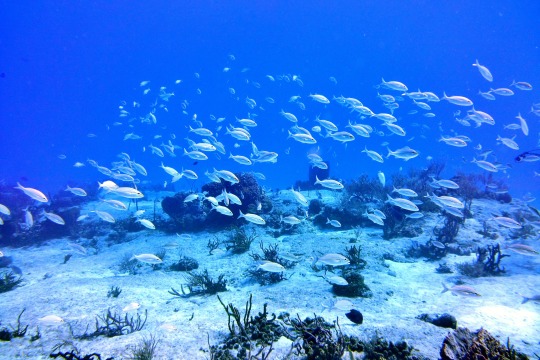
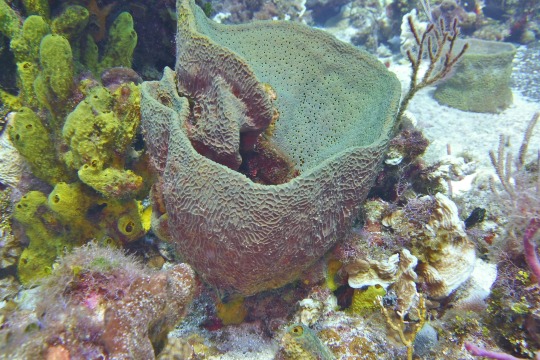



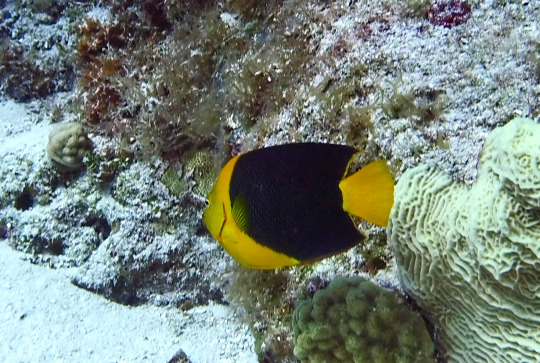




A great dive in Cozumel. It started with a beautiful sunrise before we headed out across the water.
#original photographers#photographers on tumblr#original photography#underwater photography#coral reef#ocean life#sealife#porcupine fish#squirrel fish#bluestriped grunt#barrel sponge#Rock beauty#french angelfish#white margate#blue tang
15 notes
·
View notes
Text
learning about paleobiology is so fun because it means that on the bus i will be reading and in one second overwhelmed with a feather’s brush of awareness of the vast and inky gulfs of time in which the world is subsumed and then in the next second overwhelmed with blinding petulant fury that there is no time machine i can get in to see the eocene antarctic coastal temperate rainforest full of gigantic penguins
#.txt#THERE WERE 10 FOOT LONG OTTERS ONCE. I WANT TO SEE THEM#i want to see confuciusornis sanctus! i want to see the jurassic glass sponge reefs! LET ME IN#anyway i'm reading otherlands right now. its good
4 notes
·
View notes
Photo

ζ°) ))彡
#coral#fish#reef#cute graphics#old web#webcore#geocities#angelfire#sponges#internet archive#early internet
25 notes
·
View notes
Photo





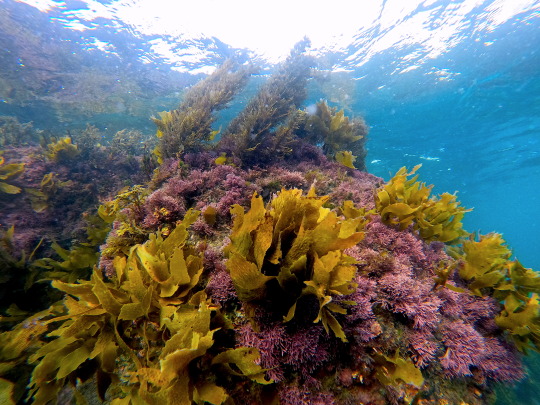
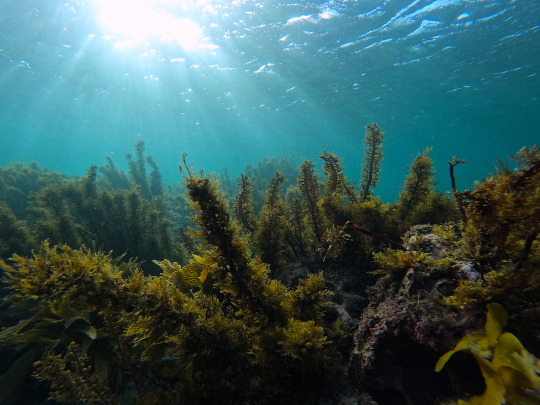



Day 141.
Goat Island.
An afternoon dive in the marine reserve. The water was clear despite the surface chop, and the colours were beautiful! so much to see along the algae walls! :)
#algae#intertebrate wall#sea sponge#kelp forest#ecklonia#pink sponge#snapper#reef#sub temperate reef#new zealand#aotearoa#underwater photography#marine life#fish#underwater#beauty
21 notes
·
View notes
Photo





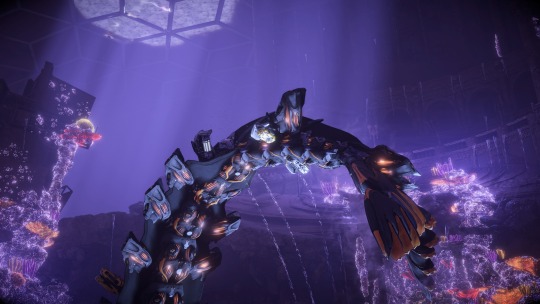

Poseidon’s dream.
My twin weaknesses. Marine life and glowy lights.
#and not an anglerfish in sight#hfw#horizon forbidden west#hfw spoilers#hfw photomode#ruins of las vegas#sea of sands#poseidon#poseidon's dream#holograms#reef life#corals and sponges#and a goddamn mechanical plesiosaur#except it's got the tail fin of a whale for some reason#species fusion#machines#hfw machines#tideripper#2 x cut scene shots#there was no other way to get the tail#singingkescam
12 notes
·
View notes
Text




1 note
·
View note
Text
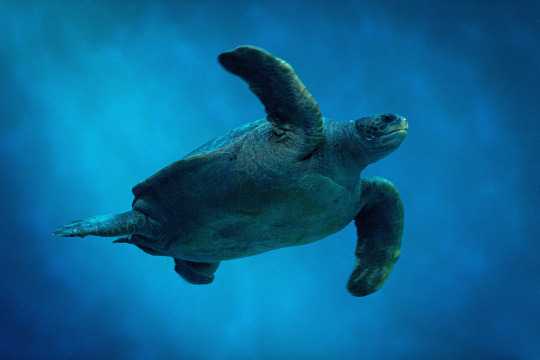
They may not be teenagers… 🌊 (sea turtles live to be 50+ years old)
They’re definitely not mutants… 🐢 (they’ve existed for over 100 million years, mostly unchanged)
They don’t even eat pizza… 🍕🍕 (depending on the species, seagrass, jellies, squid, or sponges are more likely to be on their menu)
But these heroes in a half shell have some serious turtle power! 🐢 💪In fact, sea turtles are critical to maintaining the health of the seagrass beds and coral reefs where they live.
When green sea turtles graze on seagrass, they increase the productivity and nutrient density of the blades. Similarly, by munching on sponges, hawksbill turtles provide space on reefs for corals to grow.
We think that’s pretty turtle-rific!
#monterey bay aquarium#our favorite tmnt is of course donatello#kelpabunga#heroes in a half shell#monterey bayakasha
2K notes
·
View notes
Photo

Any clownfish lovers? #coralsdaily #clownfish #anemone #sponge #corals #rbta #maroonclownfish #aquacultured #fish #tropicalfish #marinefish #aquarium #reef #reefaquarium https://www.instagram.com/p/ChhwlMXL6_3/?igshid=NGJjMDIxMWI=
#coralsdaily#clownfish#anemone#sponge#corals#rbta#maroonclownfish#aquacultured#fish#tropicalfish#marinefish#aquarium#reef#reefaquarium
0 notes
Note
vertebrates are nothing. this planet is dominated by water which is filled with plankton, algae, countless swarms of critters with a few miserable fish. the reefs are built of cnidarians, sponges, algae; crustaceans and gastropods outnumber chordates a zillion to one. even on land, beetles, flies, hymenopterans reign among the life visible to the naked eye; dwarfing them are the plants, and the fungi, and the microbes which live on and in everything. you will never get a vertebrate in a million years.
unless you're fucking Margaret Thatcher apparently.
I would love a geometrid moth, but I'll take anything without *shudders* bones
String identified:
tat a tg. t at at at c t at, aga, ct a ctt t a a . t a t caa, g, aga; ctaca a gat t cat a t . a, t, , ta g ag t t t a ; ag t a t at, a t g, a t c c a tg. gt a tat a a.
' cg agat Tatc aat.
a gt t, t ' ta atg tt **
Closest match: Poecilus cupreus genome assembly, chromosome: 5
Common name: Carabid beetle

416 notes
·
View notes
Text
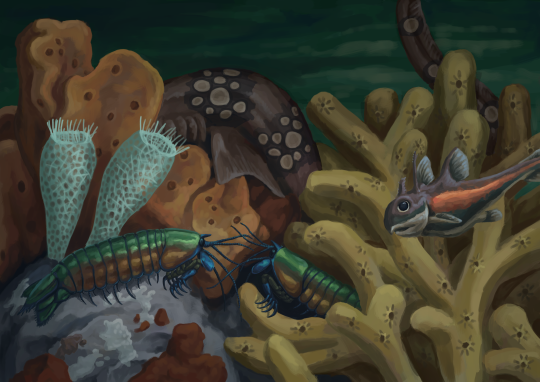
A sponge reef from the Carboniferous Bear Gulch formation. A pair of female Daidal acanthocercus mantis shrimp forage for food together (some mantis shrimp species form long term monogamous relationship pairs). Echinochimera, a strange chondrichthyan, swims past in the foreground while the elongated Thrinacodus forages between sponges.
#paleoart#palaeoart#bear gulch#mantis shrimp#sponge#aquatic#underwater art#fish#chondrichthyes#lesbian#<- the mantis shrimp are lesbians
484 notes
·
View notes
Text
"Underwater delightment"
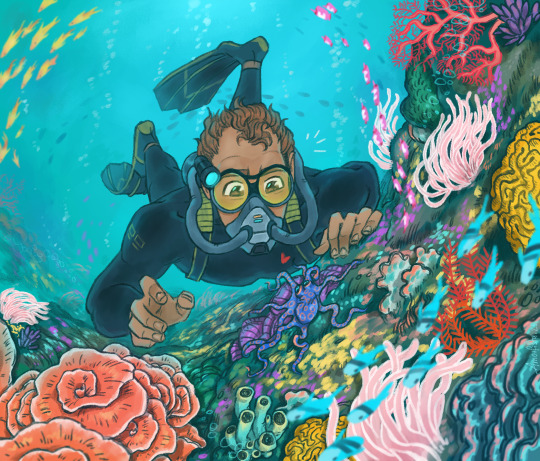
Happy Tech Tuesday!!
These past couple of days I've had the great pleasure to work on @vivaislenska's request!
I thought it was obvious that Tech would, at a certain point, craft himself a diving mask and goggles, and explore Pabu's reefs (because Pabu has reefs, it is canon now) in order to learn about its extensive marine wildlife beyond the screen of his datapad!
His scuba session takes him through a colorful arrange of corals, anemones sponges, fish, and...
"...a Hapalochlaena lunulata rubra!?" Tech excitedly thinks to himself. The odds of finding the harmless red-ringed octopus, cousin of the blue-ringed octopus were minimal, and far beyond Tech's expectations! He would have to dive back to the surface right away to note the date and time to commemorate such a momentous occasion!
But this little cephalopod was not afraid of Tech, and time seemed to freeze as they stared, completely fascinated at each other.
His notes could most certainly wait.
This piece came out fairly naturally and I'm very happy with the result ^^ And even happier to have gotten the ask in the first place. So THANK YOU VIV!! ♥

This sketch is a bit more detailed than what I usually make, so don't mind the taglist ;V;!♥ (and let me know if you'd like to be included!<;3)
@dukeoftheblackstar @justalittletomato @darthmaulshispanichousewife @botherbother-blog @aftergloom @badolmen @ihaventpickedausername @ohboi @stardustbee @nik-barinova @the-chains-are-the-easy-part @gen-has-green-vibes @ejfivercommander @herbalinz-of-yesteryear @eyecandyeoz @noesqape @lune-de-miel-au-paradis @staycalmandhugaclone @callmesunny04 @freesia-writes @ginnymilling @sunshinesdaydream @blueink-bluesoul @cloneloverrrrr @moon-wrecked @idontgetanysleep @tech-aficionado @followthepurrgil @renton6echo @queen-jiru @shoe-bag @eyayah123 @eloquentmoon @and-loth-cat @ladyzirkonia @stardusthuntress @bambambunny @morphofan @gt13tbbart
#star wars#the bad batch#clone wars#tbb tech#tech tbb#bad batch tech#tech bad batch#clone force 99#the beach batch#tech tuesday#tbb tech tuesday#my art
706 notes
·
View notes
Text
Wet Beast Wednesday: parrotfish
Which fish hangs out on a mermaid pirate's shoulder and repeats what she says in a high-pitched voice? The parrotfish, of course. Or at least in fiction they should (certainly will in my D&D world). But even in real life, parrotfish are still pretty interesting.

(Image: a common parrotfish (Scarus psittacus) seen from the side in front of rocks and corals. It is a brightly-colored fish, mainly light blue but with patches and stripes of yellow and pink on the fins. Its mouth is open, revealing what appears to be a beak. End ID)
Parrotfish are fish famous for their mouths and eating habits. There are about 90 species known. While they were historically considered their own taxonomic family, they have since been reclassified a subset of the wrasse family and there is still some debate on how to classify them. Most species are on the smaller size, but a few can get very large. The largest species is the green humphead parrotfish (Bolbometopon muricatum) at 1.5 meters (4.9 ft) and 75 kg (165 lbs) while the smallest species is the bluelip parrotfish (Cryptotomus roseus) reaching 13 cm (5 in). I could not find an average weight for the bluelips. What makes parrotfish really stand out visually is their colors and their mouths. Most species are very brightly colored, with distinct markings and males are usually more brightly colored than females. Their mouths are dominated by what appear to be beaks, which gave them their common name. These beaks are actually made of approximately 1,000 teeth arranged in 15 rows. As the teeth wear out, they drop off and are replaced by the row behind them. The teeth are made of fluorapatite, the second hardest biomineral int the world. To support their hardness, the fluorapatite crystals that make up the teeth are woven together in a structure very similar to chainmail, resulting in very hard teeth that measure in at a 5 on the Mohs scale of hardness. For reference, iron is a 4 and higher numbers are harder. The teeth can also handle 530 tons of pressure. You could put the weight of 200 black rhinos on a tooth and it would be fine. The beaks are powerful enough to bite through rock. Which is what they use it for, but more on that below. Another unusual feature of parrotfish is how they sleep. Some species make their own sleeping bags, which would be adorable if they weren't made of mucus. The mucus is produced using glands in the gills and looks like a transparent bubble. The fish sleeps in the mucus cocoon and when it wakes up, it eats the cocoon. There have been several proposed benefits of the cocoon. It contains chemicals that harm skin parasites while also providing a barrier that keeps new parasites from reaching the fish. It also likely blocks the fish's scent, helping it hide from predators.
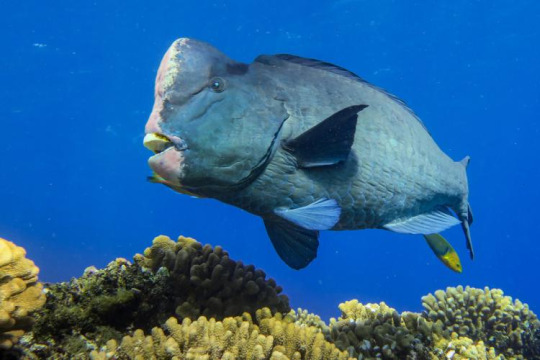
(Image: a green humphead parrotfish (Bolbometopon muricatum) swimming over yellow coral. It is large and mostly a uniform green color, except for the front of its head, which is pink. It has a large, fleshy lump on the top of its head. End ID)
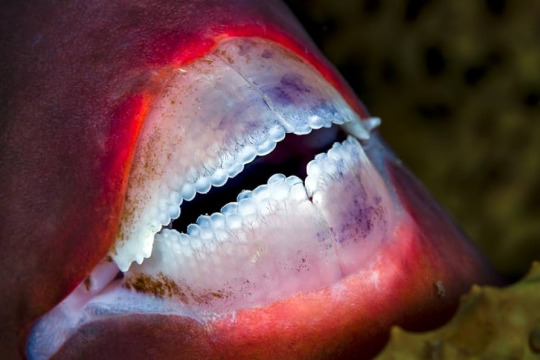
(Image: a close-up of a parrotfish's beak. The top and bottom beaks are divided into two halves, left and right. The beak is bade of small, circular teeth that overlap each other. End ID)
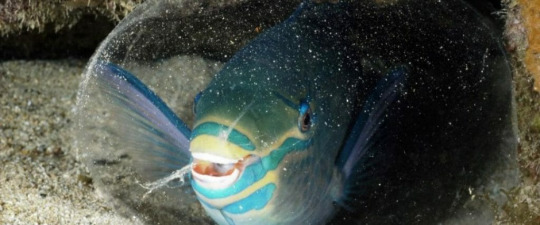
(Image: another common parrotfish seen from the front. It is inside of a mucus cocoon, which appears as a transparent bubble around the fish. Bits of sand dot the cocoon's surface. End ID)
Parrotfish live worldwide, though the majority of species are found in the Indo-Pacific. They live in warm, shallow waters with lots of rocky reefs, especially coral reefs. They use those powerful teeth to eat and what they eat most is algae. There are three main types of feeding behavior: excavating, scraping, and browsing. Excavators bite into rocks to get their food, scrapers crape food off of the surface of the rocks, and browsers go after larger food sources like seagrass and sponges. Some of the larger parrotfish species also make coral a large part of their diet. When they eat, they naturally get rock in their mouths, moreso in excavators. Because their food clings to the rock, spitting the rocks out would deny them food. Instead, parrotfish use pharyngeal teeth set in their throats to grind the rock into sand, which then passes through the digestive tract. When it exists the digestive tract, it is in the form of fine grains of rock. Or to put it another way, parrotfish eat rock and poop sand. A single parrotfish can produce up to 40 kg (88lbs) of sand yearly, and bigger species can produce even more than that. The process of rock being broken down by living things is called bioerosion and parrotfish are one of the most famous sources of bioerosion. The sand they produce can serve as the basis for new growth of coral or other species and helps reinforce nearby islands. In places like Hawai'i, the Caribbean, and the Maldives, it's estimated that up to 80% of the famous white sand is produced by parrotfish and they serve as a major source of incoming earth to support the islands. This makes parrotfish ecosystem engineers. Their eating of algae is also majorly important to their ecosystems. Algae can overgrow and smother delicate ecosystems like coral reefs and seagrass beds and decaying algae draws oxygen out of the water. Parrotfish help the health of their environments by keeping the algae population at healthy levels. Parrotfish also eat seaweeds and sponges that grow much faster than coral and can smother coral reefs. Parrotfish are considered keystone species in many reefs, including the great barrier reef and their population dropping correlates with reduced health of reefs. Damaged reefs tent to have larger parrotfish populations and those populations drop as the reef recovers.

(Image: a group of many parrotfish feeding on coral. They are all the same species and are mostly blue, with yellow heads and stripes on the face. They appear to be biting the the coral. End ID)
Parrotfish are protogynous sequential hermaprodites. This means that all parrotfish are born female and can become male later in life. The transition is usually triggered when there are too many females or not enough males in a location, though in some species any fish that reaches a certain size will become male. Some parrotfish are solitary while others are social. In social species, the social groups consist of a large male and a harem of females that he protects and claims mating rights with. Other males will attempt to fight the male for dominance via headbutting and threat displays and occasionally one of his harem members will become male to challenge him. Males are usually more colorful than females, which they use to woo females, but also puts them at greater risk of predation. If the harem leader dies and is not replaces, one member of the harem will transition to male and replace him. Many species perform courtship dances during nights of the full moon. In non-social species, males will perform displays and fight with each other to attract females. In social species, the dominant male will mate with his harem while smaller males without harems will try to sneakily woo claimed females or sneak in and mate without being noticed. Parrotfish are broadcast spawners. The female releases her eggs into the water and the males releases sperm to fertilize them. The eggs will drift on the current until settling, after which the larvae will hatch. As with most fish species, only a very few of the larvae will reach adulthood.

(Image: a Mediterranean parrotfish (Sparisoma cretense). It is mostly bright red, but with a yellow patch above the tail and a yellow stripe around the eye that runs down to the belly. A large patch behind the eye is blue. End ID)
Thankfully, most parrotfish species are not particularly endangered. The largest threat to them comes from habitat loss as pollution and climate change harms coral reefs. Reintroducing parrotfish to damaged reefs helps them recover. All species are edible, though there is no commercial fishery for them. While parrotfish are capable of delivering powerful bites, there are few reports of humans getting bit. That being said, I found one case where someone had skin on his penis bitten off by a parrotfish. And yes, that link has pictures. Enjoy.

(Image: a blue parrotfish (Scarus coeruleus) looking at the camera. It is a blue fish with darker patches around the eye. Its snout is bulbous and the beak points downward. End ID).
#wet beast wednesday#parrotfish#the smiling grinner#fish#fishblr#fishposting#marine biology#biology#zoology#ecology#animal facts#coral reef#penile trauma#that's a wild tag to have on a post about fish#informative#image described
362 notes
·
View notes